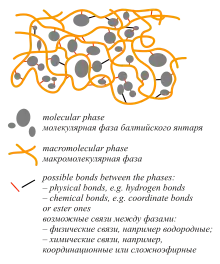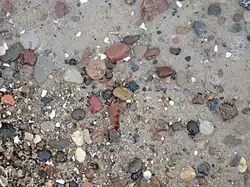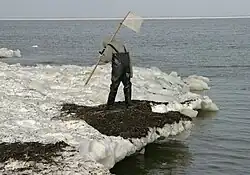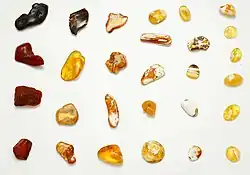.jpg.webp)

The Baltic region is home to the largest known deposit of amber, called Baltic amber or succinite. It was produced sometime during the Eocene epoch, but exactly when is controversial. It has been estimated that these forests created more than 100,000 tons of amber.[1] Today, more than 90% of the world's amber comes from Kaliningrad Oblast of Russia. It is a major source of income for the region; the local Kaliningrad Amber Combine extracted 250 tonnes of it in 2014[2] and 400 tonnes in 2015.[3]
Baltic amber formerly included amber from the Bitterfeld brown coal mines in Saxony (Eastern Germany). Bitterfeld amber was previously believed to be only 20–22 million years old (Miocene), but a comparison of the animal inclusions in 2003 suggested that it was possibly Baltic amber that was redeposited in a Miocene deposit.[4] Further study of insect taxa in the ambers has shown Bitterfeld amber to be from the same forest as the Baltic amber forest, but separately deposited from a more southerly section, in a similar manner as Ukrainian Rovno amber.[5] Other sources of Baltic amber have been listed as coming from Poland and Russia.
Because Baltic amber contains from 3 to 8% succinic acid, it is also termed succinite.
Geologic context

In situ Baltic amber is derived from the sediments of the geological formation termed the Prussian Formation, formerly called the "Amber Formation", with the main amber bearing horizon being referred to as "Blue Earth", so named due to its glauconite content. The formation is exposed in the northern part of the Sambia Peninsula in Kaliningrad. Much of the Baltic amber has been secondarily redeposited in Pleistocene glacial till deposits across the North European Plain.[6] It has been proposed that the amber is secondarily redeposited in coastal lagoonal conditions after a marine transgression of the amber forest. The age of the amber is controversial, though it is generally interpreted as having been produced during the Eocene epoch (56-34 million years ago). Different authors have given estimates of 40-47 million years ago and 35-43 million years ago as the age of the amber.[7]
Baltic amber tree
It is universally agreed that the amber is coniferous in origin. It was thought since the 1850s that the resin that became amber was produced by the tree Pinites succinifer, but research in the 1980s came to the conclusion that the resin originates from several species. More recently, it has been proposed, on the evidence of Fourier-transform infrared microspectroscopy (FTIR) analysis of amber and resin from living trees, that conifers of the family Sciadopityaceae were responsible.[1] The only extant representative of this family is the Japanese umbrella pine, Sciadopitys verticillata.
Structure

The structure of Baltic amber (succinite) is complex. It is not a polymer, because it is not composed of a repeating pattern of mers of the same type. Rather it has a macromolecular structure arranged in a crosslinked network, in which the pores (free spaces) are filled by components of molecular structure (e.g. by mono- and sesquiterpenes). Thus the chemical structure of the amber may be described as a supramolecule.[8] The structure makes the amber denser, harder and more resistant to external factors. It also makes possible good preservation of plant and animal inclusions.[9]
Paleobiology
Numerous extinct genera and species of plants and animals have been discovered and scientifically described from inclusions in Baltic amber.[10] Inclusions of insects make up over 98% of the animals preserved in the amber, while all other arthropods, annelids, molluscs, nematodes, protozoans contribute less than 0.5% of the animals. Vertebrates are another 0.5% of the animals included and mostly are represented by mammal fur, feathers, and reptiles.[11]
Flora
| Name | Authors | Year | Family | Notes | Images |
|---|---|---|---|---|---|
|
Heinrichs et al |
2015 |
||||
|
Heinrichs et al |
2014 |
||||
Fauna
- Agroecomyrmex Wheeler, 1910[14]
- Aphaenogaster mersa Wheeler, 1915[14]
- Aphaenogaster oligocenica Wheeler, 1915[14]
- Aphaenogaster sommerfeldti (Mayr, 1868)[14]
- Arostropsis Yunakov & Kirejtshuk, 2011[15]
- Aspidopleura Gibson, 2009[16]
- Asymphylomyrmex Wheeler, 1915[14]
- Balticopta gusakovi Balashov & Perkovsky, 2020[17]
- Baltimartyria Skalski, 1995
- Baltocteniza Eskov & Zonstein, 2000[18]
- Brevivulva Gibson, 2009[16]
- Deinodryinus areolatus (Ponomarenko, 1975)[19]
- Deinodryinus velteni Guglielmino & Olmi, 2011[19]
- Diochus electrus Chatzimanolis & Engel, 2011[20]
- Electrinocellia (Carpenter) Engel, 1995[21]
- Electrocteniza Eskov & Zonstein, 2000[18]
- Electropodagrion Azar & Nel, 2008[22]
- Electrostephanus Brues, 1933[23]
- Elektrithone Makarkin, Wedmann, & Weiterschan, 2014[24]
- Eogeometer vadens Fischer, Michalski & Hausmann, 2019[25]
- Epiborkhausenites Skalski, 1973[26]
- Glisachaemus Szwedo, 2007[27]
- Gracillariites Kozlov, 1987
- Metanephrocerus collini Carpenter & Hull, 1939[28]
- Metanephrocerus groehni Kehlmaier & Skevington, 2014[28]
- Metanephrocerus hoffeinsorum Kehlmaier & Skevington, 2014[28]
- Electrocrania Kuznezov, 1941
- Fibla carpenteri Engel, 1995[21]
- Metapelma archetypon Gibson, 2009[16]
- Micropterix gertraudae Kurz & Kurz, 2010
- Mindarus harringtoni (Hele, 2008)
- Neanaperiallus Gibson, 2009[16]
- Palaeovespa baltica Cockerell, 1909[29]
- Palaeovespa socialis Pionar, 2005[30]
- Prolyonetia Kusnetzov, 1941
- Propupa Stworzewicz & Pokryszko, 2006[31]
- Pseudogarypus synchrotron Henderickx, 2012[32]
- Stigmellites baltica (Kozlov, 1988) (Lepidopteran leaf mines)
- Xylolaemus sakhnovi Alekseev & Lord, 2014[33]
- Succinipatopsis Poinar, 2000[34]
- Yantaromyrmex constricta (Mayr, 1868)[35]
- Yantaromyrmex geinitzi (Mayr, 1868)[35]
- Yantaromyrmex samlandica (Wheeler, 1915)[35]
See also
References
- 1 2 Wolfe, A. P.; Tappert, R.; Muehlenbachs, K.; Boudreau, M.; McKellar, R. C.; Basinger, J. F.; Garrett, A. (2009). "A new proposal concerning the botanical origin of Baltic amber". Proceedings of the Royal Society B. 276 (1672): 3403–3412. doi:10.1098/rspb.2009.0806. PMC 2817186. PMID 19570786.
- ↑ "Russia: Amber covers beach after storm". BBC. 9 January 2015.
- ↑ "Amber mining". Amber Museum Kaliningrad.
- ↑ Dunlop, J. A.; Giribet, G. (2003). "The first Fossil Cyphophthalmid (Arachnida: Opiliones), from Bitterfeld Amber, Germany" (PDF). Journal of Arachnology. 31 (3): 371–378. doi:10.1636/h03-03. S2CID 55761131.
- ↑ Perkovsky, E. E.; Zosimovich, V. Y.; Vlaskin, A. P. (2010). "Chapter 7: Rovno amber". In Penney, D. (ed.). Biodiversity of Fossils in Amber from the Major World Deposits. Siri Scientific Press. pp. 116–136. ISBN 978-0-9558636-4-6.
- ↑ Penney, David; Acra, Fadi (2010). "Baltic Amber". Biodiversity of fossils in amber from the major world deposits. Siri Scientific Press. pp. 81–84. ISBN 978-0-9558636-4-6. OCLC 904772774.
- ↑ Moser, Marina; Burks, Roger A.; Ulmer, Jonah M.; Heraty, John M.; Kamp, Thomas van de; Krogmann, Lars (2021-05-25). "Taxonomic description and phylogenetic placement of two new species of Spalangiopelta (Hymenoptera: Pteromalidae: Ceinae) from Eocene Baltic amber". PeerJ. 9: e10939. doi:10.7717/peerj.10939. ISSN 2167-8359. PMC 8162234. PMID 34113480.
- ↑ Matuszewska A. Bursztyn (sukcynit), inne żywice kopalne, subfosylne I współczesne. Katowice, 2010.
- ↑ Matushevskaya 2013, p. 8
- ↑ Weitschat, W.; Wichard, W. (2002). Atlas of Plants and Animals in Baltic Amber. Pfeil. ISBN 978-3931516949.
- ↑ Weitschat, W.; Wichard, W. (2010). "Chapter 6: Baltic amber". In Penney, D. (ed.). Biodiversity of Fossils in Amber from the Major World Deposits. Siri Scientific Press. pp. 80–115. ISBN 978-0-9558636-4-6.
- ↑ Heinrichs, J; Schmidt, AR; Schäfer-Verwimp, A; Gröhn, C; Renner, MAM (2015). "The leafy liverwort Notoscyphus balticus sp. nov. (Jungermanniales) in Eocene Baltic amber". Review of Palaeobotany and Palynology. 217: 39–44. Bibcode:2015RPaPa.217...39H. doi:10.1016/j.revpalbo.2015.02.006.
- ↑ Heinrichs, J; Hedenäs, L; Schäfer-Verwimp, A; Feldberg, K; Schmidt, AR (2014). "An in situ preserved moss community in Eocene Baltic amber". Review of Palaeobotany and Palynology. 210: 113–118. Bibcode:2014RPaPa.210..113H. doi:10.1016/j.revpalbo.2014.08.005.
- 1 2 3 4 5 Wheeler, W. M. (1914). "The Ants of the Baltic Amber". Schriften der Physikalisch-Ökonomischen Gesellschaft zu Königsberg. 55 (4): 56–59.
- ↑ Yunakov, N.N.; Kirejtshuk, A.G. (2011). "New genus and species of broad-nosed weevils from Baltic amber and notes on fossils of the subfamily Entiminae (Coleoptera, Curculionidae)". ZooKeys (160): 73–96. doi:10.3897/zookeys.160.2108. PMC 3253632. PMID 22303121.
- 1 2 3 4 Gibson, G. A. P. (2009). "Description of three New Genera and four New Species of Neanastatinae (Hymenoptera, Eupelmidae) from Baltic Amber, with Discussion of their Relationships to Extant Taxa". ZooKeys (20): 175–214. doi:10.3897/zookeys.20.161. Archived from the original on 2010-09-22. Retrieved 2011-03-29.
- ↑ Balashov I.A. & Perkovsky E.E. 2020. An Eocene land snail Balticopta gusakovi gen.n., sp.n. (Stylommatophora: Gastrocoptidae) from Baltic amber // Invertebrate Zoology. Vol.17. No.1: 18–24.
- 1 2 Eskov, K. Y.; Zonstein, S. L. (2000). "The First Ctenizoid Mygalomorph Spiders from Eocene Baltic Amber (Araneida: Mygalomorphae: Ctenizidae)". Paleontological Journal. 34 (3): S268–S274. Part 1; part 2, PDF.
- 1 2 Guglielmino, A.; Olmi, M. (2011). "Revision of fossil species of Deinodryinus, with description of a new species (Hymenoptera, Dryinidae)". ZooKeys (130): 495–504. doi:10.3897/zookeys.130.1326. PMC 3260777. PMID 22259295.
- ↑ Chatzimanolis, S.; Engel, M. S. (2011). "A new species of Diochus from Baltic amber (Coleoptera, Staphylinidae, Diochini)" (PDF). ZooKeys (138): 65–73. doi:10.3897/zookeys.138.1896. PMC 3208521. PMID 22144854.
- 1 2 Engel, M. S. (1995). "A New Fossil Snake-Fly Species from Baltic Amber (Raphidioptera: Inocelliidae)". Psyche: A Journal of Entomology. 102 (3–4): 187–193. doi:10.1155/1995/23626. hdl:1808/16479.
- ↑ Azar, D.; Nel, A. (2008). "First Baltic amber megapodagrionid damselfly (Odonata: Zygoptera)". Annales de la Société Entomologique de France. New Series. 44 (4): 451–457. doi:10.1080/00379271.2008.10697580. – via Taylor & Francis (subscription required)
- ↑ Engel, M.S.; Ortega-Blanco, J. (2008). "The fossil crown wasp Electrostephanus petiolatus Brues in Baltic Amber (Hymenoptera, Stephanidae): designation of a neotype, revised classification, and a key to amber Stephanidae". ZooKeys (4): 55–64. doi:10.3897/zookeys.4.49. hdl:2445/36428.
- ↑ Makarkin, VN; Wedmann, S; Weiterschan, T (2014). "First record of the family Ithonidae (Neuroptera) from Baltic amber". Zootaxa. 3796 (2): 385–393. doi:10.11646/zootaxa.3796.2.10. PMID 24870683.
- ↑ Fischer, Thilo C.; Michalski, Artur; Hausmann, Axel (2019). "Geometrid caterpillar in Eocene Baltic amber (Lepidoptera, Geometridae)". Scientific Reports. 9 (1): Article number 17201. Bibcode:2019NatSR...917201F. doi:10.1038/s41598-019-53734-w. PMC 6868187. PMID 31748672.
- ↑ Skalski, A. W. (1973). "Studies on the Lepidoptera from Fossil Resins. Part II. Epiborkhausenites obscurotrimaculatus gen. et sp. nov. (Oecophoridae) and a Tineid-Moth Discovered in the Baltic Amber" (PDF). Acta Palaeontologica Polonica. 18 (1): 153–160.
- ↑ Szwedo, J. (2007). "Glisachaemus jonasdamzeni gen. et sp. nov. of Cixiidae from the Eocene Baltic amber (Hemiptera: Fulgoromorpha)" (PDF). Alavesia. 1: 109–116. Archived from the original (PDF) on 2011-07-19. Retrieved 2015-06-09.
- 1 2 3 Kehlmaier, C; Dierick, M; Skevington, JH (2014). "Micro-CT studies of amber inclusions reveal internal genitalic features of big-headed flies, enabling a systematic placement of Metanephrocerus Aczel, 1948 (Insecta: Diptera: Pipunculidae)". Arthropod Systematics & Phylogeny. 72 (1): 23–36. doi:10.3897/asp.72.e31784.
- ↑ Cockerell, T. D. A. (1906). "Fossil Hymenoptera from Florissant, Colorado". Bulletin of the Museum of Comparative Zoology. 50 (2).
- ↑ Poinar, G. (2005). "Fossil Trigonalidae and Vespidae (Hymenoptera) in Baltic Amber". Proceedings of the Entomological Society of Washington. 107 (1): 55–63.
- ↑ Stworzewicz, E.; Pokryszko, B. M. (2006). "Eocene Terrestrial Snails (Gastropoda) from Baltic Amber" (PDF). Annales Zoologici. 56 (1): 215–224.
- ↑ Henderickx, H.; Tafforeau, P.; Soriano, C (2012). "Phase-contrast synchrotron microtomography reveals the morphology of a partially visible new Pseudogarypus in Baltic amber (Pseudoscorpiones: Pseudogarypidae)". Palaeontologia Electronica. 15 (2, 17A, 11p): 1–11.
- ↑ Alekseev, VI; Lord, NP (2014). "A new species of Xylolaemus (Coleoptera: Zopheridae: Colydiinae) from Baltic amber". Baltic Journal of Coleopterology. 14 (1): 97–102. ISSN 1407-8619.
- ↑ Poinar, G. Jr. (2000). "Fossil Onychophorans from Dominican and Baltic Amber: Tertiapatus dominicanus n.g., n.sp. (Tertiapatidae n.fam.) and Succinipatopsis balticus n.g., n.sp. (Succinipatopsidae n.fam.) with a Proposed Classification of the Subphylum Onychophora". Invertebrate Biology. 119 (1): 104–9. doi:10.1111/j.1744-7410.2000.tb00178.x.
- 1 2 3 Dlussky, GM; Dubovikoff, DA (2013). "Yantaromyrmex gen. n. – a new ant genus (Hymenoptera Formicidae) from Late Eocene ambers of Europe" (PDF). Caucasian Entomological Bulletin. 9 (2): 305–314. doi:10.23885/1814-3326-2013-9-2-305-314.
Bibliography
Matushevskaya, Aniela (2013). "Natural and artificial resins – chosen aspects of structure and properties" [Натуральные и искусственные смолы – некоторые аспекты структуры и свойств]. In Kostjashova, Z. V. (ed.). Янтарь и его имитации Материалы международной научно-практической конференции 27 июня 2013 года [Amber and its imitations] (in Russian). Kaliningrad: Kaliningrad Amber Museum, Ministry of Culture (Kaliningrad region, Russia). p. 113. ISBN 978-5-903920-26-6. Archived from the original on 2020-02-16. Retrieved 2016-06-18.



